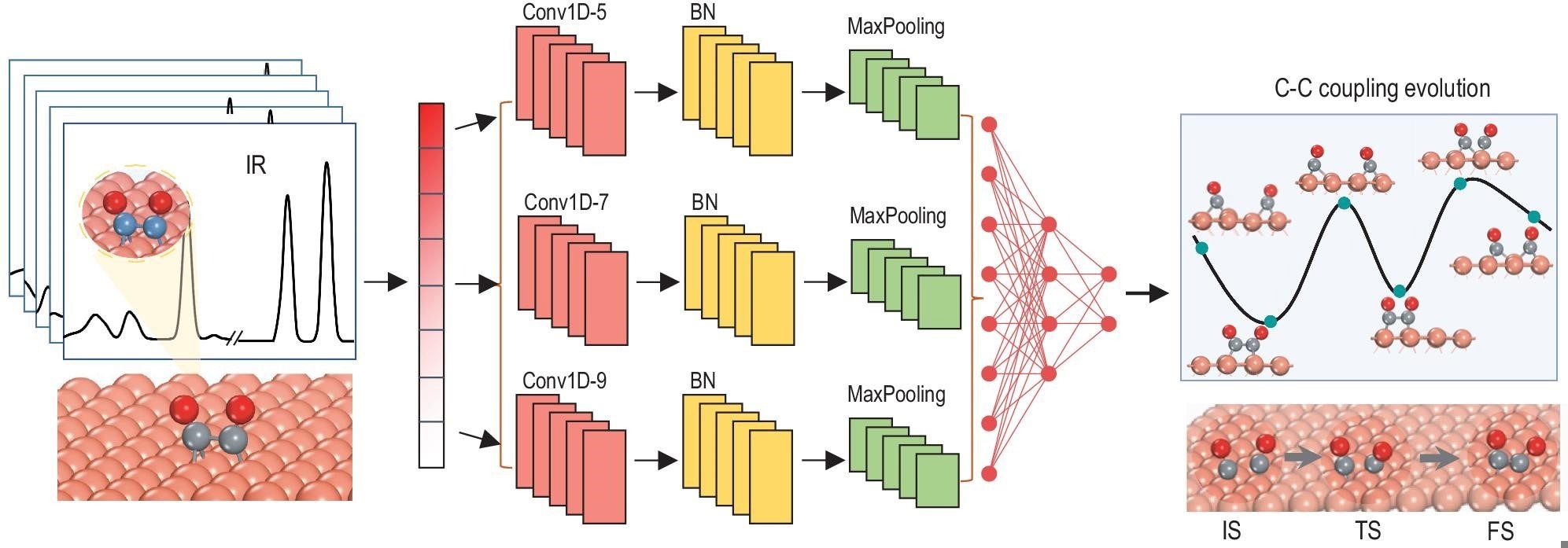AI-powered infrared spectroscopy is revolutionizing the way we track and understand chemical reactions, offering new pathways for sustainable catalysis and CO2 conversion.
 Schematic illustration of the machine learning protocol for monitoring the C–C coupling in catalytic reactions via IR spectroscopy. Brown, gray and red balls stand for Cu, C and O atoms, respectively. Conv1D-5/7/9 represent one-dimensional convolution with various sizes, BN stands for batch normali
Schematic illustration of the machine learning protocol for monitoring the C–C coupling in catalytic reactions via IR spectroscopy. Brown, gray and red balls stand for Cu, C and O atoms, respectively. Conv1D-5/7/9 represent one-dimensional convolution with various sizes, BN stands for batch normali
A study is led by Associate Prof. Li Yang, Prof. Sheng Ye (Anhui University), Prof. Thomas Heine (Technische Universität Dresden), Prof. Jun Jiang (University of Science and Technology of China), and Zhicheng Zhao, Tongtong Yang, and Donglai Zhou, among others, uses infrared spectroscopy as a noninvasive method to probe molecular transformations, coupled with a machine-learned protocol to map the spectroscopic fingerprints to atomistic structures. The research is published in the journal National Science Review.
To intuitively illustrate this approach, they selected C–C coupling involving the interaction of two adjacent CO intermediates as a representative demonstration (see image below). They designed a convolutional neural network (CNN) featuring multi-branch convolutional layers, batch normalization, and squeeze-and-excitation blocks for the machine learning architecture. By investigating the multiple dynamic trajectories of C–C coupling on the Cu surface, they demonstrated that this network can accurately predict local atomistic structures of the active surface evolution and the energetic variations by deciphering IR spectroscopy. This CNN design enhances the network's ability to recognize intricate structural features, ensuring reliable predictions. This way, the structural rearrangements during C–C coupling could be recapitulated in detail, presenting a cost-effective strategy to monitor dynamic C–C coupling.
Furthermore, concerning the critical role of the CO–CO dimerization reaction involved in C–C coupling, the authors specifically applied the trained machine learning model to the Cu surface's CO–CO dimerization reaction. Their modeling included rigorous transition state searches and analysis across 45 metal-doped Cu surfaces, leveraging transfer learning techniques to extend the model's applicability. They were able to derive crucial configurations and corresponding energy barriers from the IR spectroscopy data, setting a facile strategy to define the reaction profiles. Even on unfamiliar Cu-based surfaces, the reaction pathways could also be identified within the fine-tuning machine learning model. For example, the model demonstrated that Ag-Ru co-doped Cu surfaces reduce the energy barrier more effectively than pure Cu, aligning well with prior experimental findings. In particular, the predicted enhancement of CO–CO dimerization via metal dopant agrees well with previous experimental findings, confirming the reliability of the machine learning model.
Dr. Li Yang and the collaborators integrate IR spectroscopy, first-principles calculations, and machine learning to provide a simple yet effective venue to track structural evolution in the C–C coupling process. This approach achieved high validation accuracy, with Pearson coefficients above r=0.995r = 0.995r=0.995 and RMSD values below 0.19 Å across critical structures, underscoring the practicality and versatility of the proposed machine learning protocol for tracking complex structural evolution. It enables efficient model training using theoretical spectral data and holds promise for further refinement by incorporating experimental data to capture real-world environmental effects. This combination of computational rigor and experimental adaptability represents a significant step forward for "AI for Science" in chemical reaction research.
Source:
Journal reference:
- Yang, L., Zhao, Z., Yang, T., Zhou, D., Yue, X., Li, X., Huang, Y., Wang, X., Zheng, R., Heine, T., Sun, C., Jiang, J., & Ye, S. (2025). Monitoring C–C coupling in catalytic reactions via machine-learned infrared spectroscopy. National Science Review, 12(2). DOI:10.1093/nsr/nwae389, https://academic.oup.com/nsr/article/12/2/nwae389/7875254